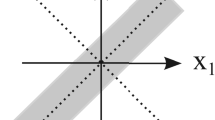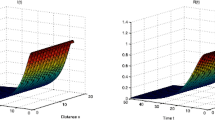Abstract
Traveling waves are analyzed in a model of the hantavirus infection in deer mice. The existence of two kinds of wave phenomena is predicted. An environmental parameter governs a transition between two regimes of propagation. In one of them the front of infection lags behind at a constant rate. In the other, fronts of susceptible and infected mice travel at the same speed, separated by a constant delay. The dependence of the delay on system parameters is analyzed numerically and through a piecewise linearization.
Similar content being viewed by others
References
Abramson, G., A. R. Bishop and V. M. Kenkre (2001). Effects of transport memory and nonlinear damping in a generalized Fisher’s equation. Phys. Rev. E 64, 066615-1-6.
Abramson, G. and V. M. Kenkre (2002). Spatio-temporal patterns in the hantavirus infection. Phys. Rev. E 66, 011912-1-5.
Childs, J. E. et al. (1994). Serologic and genetic identification of Peromyscus maniculatus as the primary rodent reservoir for a new hantavirus in the southwestern United States. J. Infect. Dis. 169, 1271–1280.
Ernest, S. K. M., J. H. Brown and R. R. Parmenter (2000). Rodents, plants, and precipitation: spatial and temporal dynamics of consumers and resources. Oikos 88, 470–482.
Fisher, R. A. (1937). The wave of advance of advantageous genes. Ann. Eugenics 7, 355–369.
Mills, J. N., T. G. Ksiazek, C. J. Peters and J. E. Childs (1999a). Long-term studies of hantavirus reservoir populations in the southwestern United States: a synthesis. Emerging Infect. Dis. 5, 135–142.
Mills, J. N., T. L. Yates, T. G. Ksiazek, C. J. Peters and J. E. Childs (1999b). Long-term studies of hantavirus reservoir populations in the southwestern United States: rationale, potential, and methods. Emerging Infect. Dis. 5, 95–101.
Murray, J. D. (1993). Mathematical Biology, 2nd edn, New York: Springer.
Nichol, S. T., C. F. Spiropoulou, S. Morzunov, P. E. Rollin, T. G. Ksiazek, H. Feldmann, A. Sanchez, J. Childs, S. Zaki and C. J. Peters (1993). Genetic identification of a hantavirus associated with an outbreak of acute respiratory illness. Science 262, 914–917.
Parmenter, R. R., J. W. Brunt, D. I. Moore and E. S. Morgan (1993). The Hantavirus Epidemic in the Southwest: Rodent Population Dynamics and the Implications For Transmission of Hantavirus-associated Adult Respiratory Distress Syndrome (HARDS) in the Four Corners Region. Sevilleta LTER Publication No. 41, pp. 1–45.
Parmenter, C. A., T. L. Yates, R. R. Parmenter and J. L. Dunnum (1999). Statistical sensitivity for detection of spatial and temporal patterns in rodent population densities. Emerging Infect. Dis. 5, 118–125.
Parmenter, C. A., T. L. Yates, R. R. Parmenter, J. N. Mills, J. E. Childs, M. L. Campbell, J. L. Dunnum and J. Milner (1998). Small mammal survival and trapability in markrecapture monitoring programs for hantavirus. J. Wildl. Dis. 34, 1–12.
Stickel, L. F. (1968). Home range and travels, in Biology of Peromyscus (Rodentia), Special publication No. 2, J. A. King (Ed.), Stillwater, Oklahoma: The American Society of Mammalogists, pp. 373–411.
Terman, C. R. (1968). Population dynamics, in Biology of Peromyscus (Rodentia), Special publication No. 2, J. A. King (Ed.), Stillwater, Oklahoma: The American Society of Mammalogists, pp. 412–450.
Vessey, S. H. (1987). Long-term population trends in white-footed mice and the impact of supplemental food and shelter. Am. Zoologist 27, 879–890.
Yates, T. L. et al. (2002). The ecology and evolutionary history of an emergent disease: hantavirus pulmonary syndrome. Bioscience 52, 989–998.
Author information
Authors and Affiliations
Corresponding author
Rights and permissions
About this article
Cite this article
Abramson, G., Kenkre, V.M., Yates, T.L. et al. Traveling waves of infection in the hantavirus epidemics. Bull. Math. Biol. 65, 519–534 (2003). https://doi.org/10.1016/S0092-8240(03)00013-2
Received:
Accepted:
Issue Date:
DOI: https://doi.org/10.1016/S0092-8240(03)00013-2




